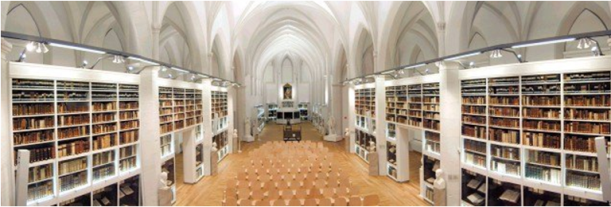|

The Pauliner
Church – which now forms part of the historical building
compound of Göttingen State and University Library – is an architectural
monument of the highest rank.
It was the first church in Göttingen built in Gothic style and was used by
the Dominicans as part of their monastery (founded in 1294). The building
reflects the architectural tradition of the mendicant order.
When the Reformation started in Göttingen in 1529, the Dominicans had to
struggle for the survival of their monastery. Since the town council had no
authority over parish churches – these were under ducal patronage – the city
leaders decided to hold Lutheran services in the mendicant churches, in
particular in the Dominican church, as it was the town’s largest. Thus, the
Pauliner Church was the place in Göttingen where the earliest protestant
baptism was administered.
After secularization in the sixteenth century, a grammar school was set up
in the former Dominican monastery and soon enjoyed widespread reputation.
The school formed the heart of what later became the university (founded in
1737) and its library (founded in 1734 already).
Initially the church was used for religious services, but soon these were
held elsewhere since there was not sufficient space for the rapidly growing
library. Gradually it took over the entire building complex including the
Pauliner Church itself.
In 1812, Jérôme Napoleon had a mezzanine floor inserted into the church. The
upper storey thus created was transformed into a library hall, in a harmonic
blend of Gothic and Classic style as it can be seen again today.
Goethe, Heinrich Heine, and the Grimm Brothers visited the library
frequently. Johann Wolfgang von Goethe was one of the most ardent admirers
of the library and a keen user of its holdings. For Christian Gottlob Heyne,
professor and librarian in Göttingen, the "Historical Hall" (the name stems
from the fact that the history books were kept here), constituted the
culmination of decades of hard work. Heinrich Heine made this hall the
climax of the library dream in his Harzreise.
Since moving into its new building in 1992, Göttingen State and University
Library has used the hall as an exhibition room. Successful exhibitions of
national importance, such as "Wagnis der Aufklärung – Georg Christoph
Lichtenberg" [Venturing the Enlightenment – Georg Christoph Lichtenberg],
"700 Jahre Paulinerkirche" [Seven-hundred years Pauliner Church], and
"Goethe, Göttingen und die Wissenschaft" [Goethe, Göttingen, and science]
were presented there.
With "Gutenberg und seine Wirkung" [Gutenberg and his effects] in June 2000,
the hall was reopened to the public again in its historical form – with the
addition of the air-conditioned and high-security Schatzhaus, allowing for
the display of very valuable items. The Pauliner Church is not only a venue
for exhibitions; it provides a special ambience for public events as well.
|

